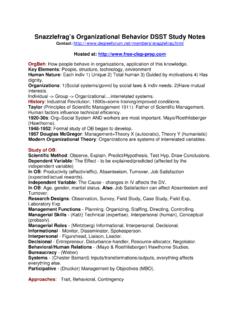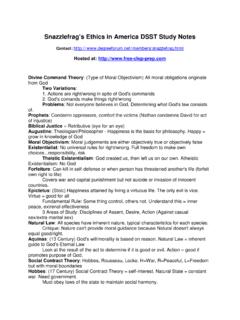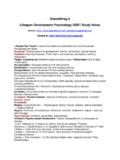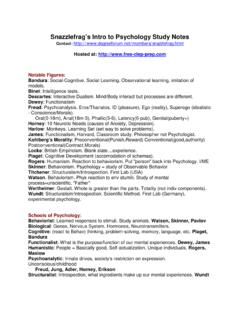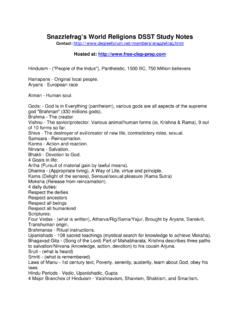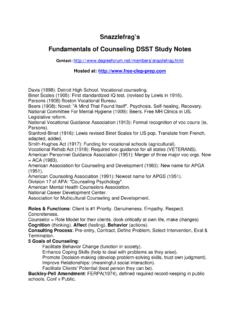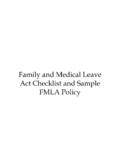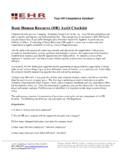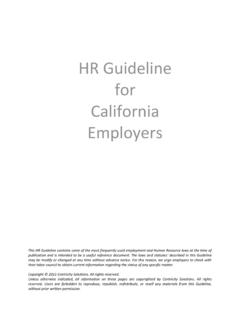Transcription of Snazzlefrag’s Human Resource Management DSST Study …
1 snazzlefrag sHuman Resource ManagementDSSTS tudy NotesContact: at: , staffing, selection, orientation, promotion/transfer, layoffsJob Analysis, Training, Appraisal, Motivation/Communication, Compensation, Safety,Legal, Labor RelationsHuman Resource Planning (HRP)-predict labor supply, job training, equalopportunitiesHRP = Strategic Planning-analysis > formulation > implementationAnalysis-business goals, strong/weak points, competetive advantageFormulation ( Management Methodology)-Business mission, values, objectives, Resource allocationsJob Analysis-tasks, duties, activities involved in a particular job--> create JobDescriptions (product/perf)Interviews, questionnaires, observation, diaries (job analysts)Functional Analysis, Position Analysis Questionnaire, Critical Incident Method,Computerized ModelJob Description-used to improve performance appraisals, training manuals etc.
2 (adhere to EEO laws)Job Design-Process of restructuring jobs to enhance organizational efficiency and jobsatisfactionJob Enrichment Model, Job Characteristics Model (responsibility, meaningfulness,knowledge of results)Employee EmpowermentHiring Process-Job Analysis > Recruitment > screening > application > interview >Test > , Seniority, PotentialPeter Principle-rise to highest level of competence then promoted and remain at levelof incompetenceInternal Recruitment-cost-effective, loyalty-Drawbacks = ignore most suitable,infighting, inbreedingContingent Workforce (free agents)-freelancers, part-time, sub-contractors, tempsKSAO (person-job fit)-Knowledge, skills, abilities, other factors (personality, values,motivation)
3 Person-organization Fit-Same Values, Ethics, Culture of the companySelection-Clinical Approach (personal judgement), Statistical Approach (objectivedecision)Selection Procedures-application form, interview, employment test (KSAO),background, Medical/DrugTest Reliability-Consistent results if taken repeatedlyby same personTest Validity-Accurately measures a person's abilities. (don't test for the wrong thing)Banned Questions (EEO)-Age, gender, race, marital status, sexual orientationEmployment Tests-Aptitude (ability to learn new skills), Achievement (current skills)
4 Physical Ability Test, Job Knowledge Test, Work Sample TestInterview Types-nondirective, structured, situational, behavioral description, panel,computer, videoOrientation-Intro to workmates, dress code, attendance/behavior, pay, hours, jobfunctions, safetyCareer Planning-values, strengths, weaknesses, interests, abilities, goals > matched tocareer path8-Principles of Learning-Goal setting, individualdifferences, practice/repetition, wholev part learningmassed v distrib learning, feedback/reinforce, meaningfulness of presentation, modelingProcess Dynamics (team)
5 -meeting skills, problem solve, brainstorming, projectplanning, goal setting40% illiterate, 50% of US companies sponsor diversity trainingSystems Approach to Training Programs-thorough assessment4 stages-needs assessment, program design, implementation, evaluationNeeds Assessment = Organiz Analysis, Task Analysis, Person AnalysisEvaluation = Reactions/feedback, learning, behavior, resultsTraining methods-OTJ, apprent, cooperative, class, self-directed, audiovisual,e-learning, simulationManagerial Training-seminar, conferences, case studies, OJT, roleplay, behaviormodelingManagerial OJT = coaching, understudy, lateral transfer, job rotationCareer Development Program-matches needs of employee to those of the companyLeadership Development Plan-when strategic change or creating a transnationalstructureBenchmarking-Ameri can Soeciety for Training & Development (compares programs,costs, staffing)
6 Performance Appraisals-Evaluation, Administrative, Developmental, EEO complianceAdmin = compensation planning, personnel decisions, evaluating training programsAppraisal Program-Set Performance Standards (from job analysis),Performance Standards = strategic relevance, criterion deficiency, criterion contamin,reliabilityAlbermarle v Moody = clearly defined performance standardsTeam Appraisal-based on TQM (customer needs) > team achievement rather thanindivid perfAppraisal Errors-Central tendency, leniency/strictness, recency, contrast, similar-to-meAppraisal Methods-Trait Method, Behavior Method, Results MethodTrait Method-graphic rating-scale, mixed-standard, forced-choice, essayEasy to develop and complete but subjective and not useful for feedbackBehavioral Method-critical incident, behav checklist, behav anchored rating scale(BARS),behavior observation scale (BOS) (frequency of bad or good behavior)
7 Beh Method = detailed, enables feedback but expensive and time-consumingResults Method-measures achievements-it is UNRELIABLE so they use MBOM anagement By Objectives (MBO) Assesses performance measured againstpre-agreed goals3 Types of Appraisal Interview: Tell and Sell, Tell and Listen, Problem-solvingTell and Sell-rater uses persuasion to change employees behaviorTell and Listen-rater relates pos and neg aspects of employee's perf (then emp canrespond)3 factors in Diagnosing Employee Performance: Ability, Motivation, EnvironmentStrategic Compensation (pay-for-performance)-rewards to stimulate motivation &growthNot paid market rate, instead rewarded for personalacheivements or groupcontributionsValue Added (value chain)-wages & incentives benefit both employee and Labor Standards Act (FLSA)-nonexempt = overtime, exempt = white collarDept of Labor determines if an employee is exempt based on possessing independentjudgment Mix-Internal & External factors (employer ability to pay, going rate for job, ConsPrice Index)
8 Job Evaluation-assessing relative worth of job to establish pay rate within company(large companies)4 Methods of Job Evaluation-ranking (common), classification(grades), point system,factor comparisonHay Plan-Job evaluation process designed for Managers-Knowledge, prob-solving,accountabilityRed Circle Rates-when senior Management are paid above theset pay Plans: piecework, standard hour(paid for set hrs even if finish faster),bonuses, merit pay(base^)Executive Compensation Plans: Base Salary, Short-term incentives, Long-termincentives, PerquisitesScanlon Plan (gainsharing plans)-Incentives for employee suggestionsEmployee Stock Ownership Plan (ESOP)-Stocks go into a exemptEmployee Benefits-Indirect of average employer's Benefits (cafeteria plan): Employees can choose the benefits they need(expensive)Varity Corp v Howe: Employees have a right to accurate information about benefitentitlementsMandatory Benefits: Social Security, Unemployment Insurance, Workers CompInsuranceUnemployment Insurance.
9 Social Security weeks if Benefits: retirement/pension, paid vacation, life insurance, health insuranceOccupational Safety and Health Act (OSHA)-1970 Compulsory work safety/healthstandardsCovers: General Industry, Maritime, Construction, AgricultureHuman Resources Manager is responsible for OSHA compliance of Labor enforces OSHA: workplace inspections, citations, penalties Laws: employers must inform employees about hazmat they may workwithEmployment-at-will: Has to be modified for public sector (5th Amendment), State/localgov (14th)3 Exceptions (some states): Implied Contract, Implied covenant, Violation of Dismissal: Employee is "forced" to resign by unpleasant/unreasonablework conditionsPrivacy Act 1974: Access to personnel files: Employees have right to view and correctinaccuraciesHot-stove Rule: Punishment is meted out immediately and consistently inunbiased/professional wayPositive/Nonpunitive Disciplinary Action: Cooperation between supervisor andemployee to Disciplinary Action.
10 Increasing severity to motiviate employee to , Written, Suspension, Dispute Resolution (ADR): Step review, open-door, ombudsman, arbitration,mediation1926 Railway Labor Act: first federal labor law-disputes between union and railwayboard1932 Norris-LaGuardia Act: Allows unions peaceful striking, boycotting, picketing1935 Wagner Act (NLRA) National Labor Relations Act: protected unions and collectivebargaining1938 Fair Labour Standards Act: wages, overtime, child labo
